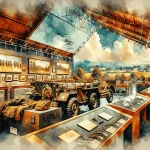The National WWII Museum in New Orleans is a powerful tribute to the valiant efforts and sacrifices made by the Allied forces during World War II. This world-class institution immerses visitors in the profound experiences of those who fought, persevered, and ultimately triumphed in one of history’s most significant conflicts.
In This Article
TL;DR
- The museum vividly portrays WWII’s history through immersive exhibits, educational programs, and an extensive collection of artifacts.
- Unique displays highlight pivotal events like the D-Day invasion, the Pacific theater, and the Merchant Marine’s crucial role.
- Community outreach initiatives and partnerships foster a deeper understanding of WWII’s societal impact.
Historical Significance of the Museum
Envisioned initially as the National D-Day Museum by historian Stephen E. Ambrose, the institution’s roots date back to 2000 when it opened to commemorate the 56th anniversary of the Normandy landings. Over time, it evolved into a comprehensive World War II museum, playing a vital role in preserving the stories, artifacts, and historical narratives of this era.
The museum’s location in New Orleans is intrinsically tied to the city’s wartime contributions. It was here that Andrew Higgins, a local industrialist, designed and manufactured the iconic Higgins Boats – shallow-draft landing craft that proved instrumental in the D-Day invasion and other amphibious operations. By housing this museum, New Orleans honors its pivotal role in the Allied victory.
Unique Exhibits and Collections
The National WWII Museum boasts an extensive collection of artifacts, each with its own story to tell. The immersive exhibits transport visitors to the heart of the conflict, offering a multisensory experience that brings history to life.
One of the museum’s centerpieces is the U.S. Freedom Pavilion: The Boeing Center, where visitors can marvel at iconic aircraft suspended from the ceiling, including the legendary B-17 Flying Fortress and the B-25 Mitchell bomber. Interactive displays and multimedia presentations provide in-depth insights into the technological advancements and strategic decisions that shaped the course of the war.
The museum also pays tribute to the local heroes of New Orleans, showcasing the contributions of the city’s residents to the war effort. The Higgins Boat exhibit, for instance, highlights the ingenuity of Andrew Higgins and the vital role his vessels played in amphibious operations.
Educational Programs and Community Engagement
Beyond its exhibits, the National WWII Museum is dedicated to fostering a deeper understanding of World War II through educational initiatives and community engagement programs.
The museum offers a range of educational resources for students and teachers, including curriculum guides, virtual field trips, and professional development opportunities. These programs aim to bring the lessons of WWII into classrooms, inspiring younger generations to appreciate the sacrifices made and the enduring impact of this pivotal event.
Additionally, the museum hosts special events, workshops, and lectures featuring renowned historians, authors, and veterans. These interactive experiences provide a platform for dialogue, allowing attendees to engage directly with experts and gain deeper insights into the complexities of World War II.
Architectural and Spatial Analysis
The National WWII Museum’s architecture is a harmonious blend of modern design and historical reverence. The striking pavilions and expansive spaces create an immersive environment that complements the exhibits and enhances the visitor experience.
The museum’s layout is thoughtfully designed to guide visitors through a chronological narrative, with each exhibit building upon the previous one. The open spaces and soaring ceilings create a sense of grandeur, while the use of multimedia and interactive displays keeps visitors engaged and captivated.
Accessibility is a priority at the museum, with features such as ramps, elevators, and audio guides ensuring that all visitors can fully experience the exhibits and participate in the educational programs.
Visitor Experience and Engagement
Visiting the National WWII Museum is an unforgettable journey through history. From the moment you step inside, you are transported to a world of heroism, sacrifice, and resilience.
To make the most of your visit, it’s recommended to plan ahead and allocate ample time to explore the museum’s vast collection. Guided tours, led by knowledgeable docents, offer a deeper dive into the exhibits and provide valuable context and insights.
Visitor testimonials and reviews consistently praise the museum’s attention to detail, the immersive exhibits, and the profound impact the experience has on one’s understanding of World War II. Many visitors express a renewed appreciation for the sacrifices made by those who served and a deeper connection to this pivotal chapter in history.
Impact on Local Community and Tourism
The National WWII Museum has become a cornerstone of New Orleans’ cultural landscape, attracting visitors from around the world and contributing significantly to the city’s tourism industry.
Beyond its economic impact, the museum plays a vital role in fostering a sense of pride and community within New Orleans. Its commitment to preserving local history and honoring the contributions of New Orleanians during World War II has strengthened the city’s identity and deepened its connection to this pivotal era.
The museum also supports various community projects and veteran affairs initiatives, further solidifying its position as a pillar of the local community and a beacon of remembrance and respect for those who served.
Comparisons and Contextualization
While there are numerous military museums across the United States and around the world, the National WWII Museum in New Orleans stands out for its comprehensive and immersive approach to preserving the history of World War II.
Unlike many traditional museums that rely heavily on static displays, the National WWII Museum employs cutting-edge technology and interactive exhibits to engage visitors on a deeper level. This innovative approach has set a new standard for military history museums, inspiring others to adopt similar techniques and elevate the visitor experience.
Moreover, the museum’s focus on the human experience of war, coupled with its commitment to educational outreach, sets it apart from institutions that primarily showcase military hardware and tactics. By highlighting the stories of individuals – soldiers, civilians, and those on the home front – the museum fosters a deeper understanding of the war’s impact on society and its enduring legacy.
Future Prospects and Developments
The National WWII Museum remains committed to expanding its offerings and adapting to changing perspectives on military history. Upcoming exhibits and planned expansions aim to explore new narratives and shed light on underrepresented stories from World War II.
One of the museum’s long-term goals is to broaden its educational outreach, leveraging digital platforms and virtual experiences to make its resources accessible to a global audience. Partnerships with educational institutions and military organizations will further enhance the museum’s ability to disseminate knowledge and foster a deeper appreciation for the lessons of World War II.
As societal attitudes towards war and conflict evolve, the museum faces the challenge of presenting historical narratives in a nuanced and sensitive manner, while remaining true to its mission of preserving the stories of those who lived through World War II. By embracing diverse perspectives and fostering open dialogue, the museum can continue to serve as a beacon of understanding and a catalyst for meaningful conversations about the complexities of war and its lasting impact on humanity.






